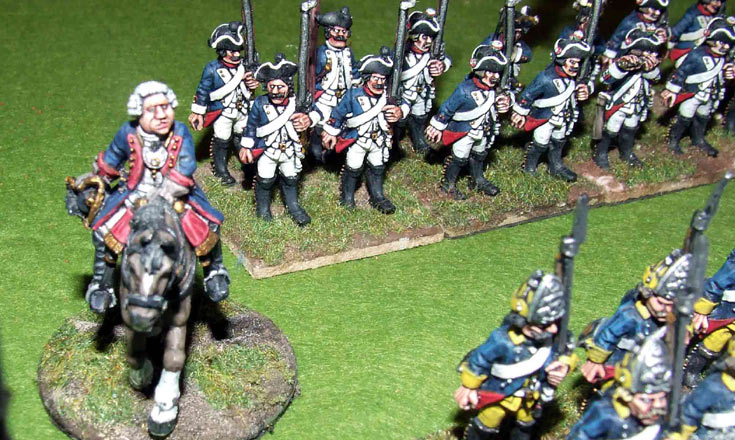
The Battle of Emsdorf, 1760
22nd September 2007, Comments Off
Seven Years War, Die Kriegskunst, 28mm
Well, this made a change from what seemed like an interminable string 20th century games. The idea was to playtest a scenario for Die Kriegskunst, our Seven Years War adaptation ofGeneral de Brigade. Actually, it’ll be more than a scenario – we’ll be using this small engagement – the Battle of Emsdorf – as our example of play in the rules, a blow-by-blow explanation of how everything hangs together. The battle was fought on 14th July 1760, between two brigade-sized forces. The defenders – a French brigade (which consisted mainly of German troops) was surprised in its camp by a slightly larger and more experienced force of Hessians, Hanovarians and British, commanded by the Prince of Hesse-Kassel. As our pals with British and French armies weren’t around we had to use substitutes. My force – the French – used Russian foot and dragoons, and two battalions of Reichsarmee. The attacking Allies consisted entirely of Dougie Trail’s Prussians. Still, this was a little playtest session, not a major photo opportunity!
As our pals with British and French armies weren’t around we had to use substitutes. My force – the French – used Russian foot and dragoons, and two battalions of Reichsarmee. The attacking Allies consisted entirely of Dougie Trail’s Prussians. Still, this was a little playtest session, not a major photo opportunity! It all went horribly wrong from the start. While a mixed force of Allied infantry and cavalry advanced against the French front, a sizeable chunk of the Allied army appeared on their left flank. The rules make it difficult to change orders, so reacting to a new threat is something of a problem, especially given the constraints of linear warfare. my only possible option was to throw my cavalry at the problem. the French hussars – er .. who looked remarkably like Russian dragoons charged in, but failed to charge home. Instead they milled around in effective musket range, until they retired from the table. I could see that this wasn’t going to be a day of glory for French arms!
It all went horribly wrong from the start. While a mixed force of Allied infantry and cavalry advanced against the French front, a sizeable chunk of the Allied army appeared on their left flank. The rules make it difficult to change orders, so reacting to a new threat is something of a problem, especially given the constraints of linear warfare. my only possible option was to throw my cavalry at the problem. the French hussars – er .. who looked remarkably like Russian dragoons charged in, but failed to charge home. Instead they milled around in effective musket range, until they retired from the table. I could see that this wasn’t going to be a day of glory for French arms! A second Allied force appeared on the French left – a small unit of British light dragoons (disguised as Prussian hussars), where two battalions of Reichsarmee troops were holding the line. the cavalry caught the rearmost battalion before they could react, and they fled in retreat, chased by the Allied cavalry. The only success story came in the centre, where the three battalion of the royal Bavarian regiment (played by Russians) held their ground in the face of an Allied infantry assault. Of course even this was playing into the hands of the Allied commander, as the pincers were rapidly closing in behind them. In the real battle the skilled French commander General Glaubnitz managed to extricate half his force and lead it to safety. By the end of the evening it was fast becoming clear that my wargame force would be mincemeat, so we were forced to concede the day.
A second Allied force appeared on the French left – a small unit of British light dragoons (disguised as Prussian hussars), where two battalions of Reichsarmee troops were holding the line. the cavalry caught the rearmost battalion before they could react, and they fled in retreat, chased by the Allied cavalry. The only success story came in the centre, where the three battalion of the royal Bavarian regiment (played by Russians) held their ground in the face of an Allied infantry assault. Of course even this was playing into the hands of the Allied commander, as the pincers were rapidly closing in behind them. In the real battle the skilled French commander General Glaubnitz managed to extricate half his force and lead it to safety. By the end of the evening it was fast becoming clear that my wargame force would be mincemeat, so we were forced to concede the day. However, as a playtest session it worked well, and we’ll replay this little battle again soon, taking more detailed notes of what happens. We’ll also have to figure out a way of tweaking it to give the French more of a chance – such as making Glaubitz a good quality commander, which means he might have a better chance of pulling his army together before the enemy struck. Oh, and next time we plan to replace the substitute figures with the real thing!
However, as a playtest session it worked well, and we’ll replay this little battle again soon, taking more detailed notes of what happens. We’ll also have to figure out a way of tweaking it to give the French more of a chance – such as making Glaubitz a good quality commander, which means he might have a better chance of pulling his army together before the enemy struck. Oh, and next time we plan to replace the substitute figures with the real thing!

